By
Marc Jitab
October 18, 2021
Updated
September 20, 2023
Source: Alexander Supertramp/Shutterstock
From enhanced IoT connectivity to immersive AR experiences, discover the endless possibilities of 5G for your business.
While the average consumer begins to enjoy the faster speeds of 5G networks in countries that have rolled out commercial 5G, it is businesses that stand to reap the most significant benefit from this new technology.
There are six key characteristics of 5G that benefits businesses:
- First, it has very low latency, so sending and receiving information takes less than ten milliseconds.
- Second, it has a very high bandwidth, averaging 100MB/s with theoretical peak transmission rates at 20GB/s.
- Third, it has the capacity to serve up to 1 million devices per square kilometre.
- Fourth, it is a very reliable network, delivering up to 99.999% uptime.
- Fifth, it is excellent for mobility as 5G radio nodes can communicate with devices moving up to 500 km/h (310 mph).
- Sixth, 5G devices are optimised for low power consumption, with some devices enjoying up to a decade of battery life.
5G is a crucial enabler for the smart Internet of Things (IoT) devices that are finding their way into all manner of business uses.
These smart devices include the smartphones workers use to monitor the movement of supply chain assets to temperature sensors on the production line or even wearables that help ensure people on the manufacturing shop floor are working within safe spatial parameters.
"[The new 5G] network is estimated to be up to 100 times faster than the present 4G systems, with up to 25 times lower latency (lag time) and as many as one million devices supported per square km; that's a staggering one thousand times what's currently possible." - Kaspersky Labs
As a result, these developments show the potential to enable new work models for many companies. It will allow a command centre controller to be positioned in Singapore while monitoring and controlling a production line in Hanoi.
The speed and amount of information supported by 5G networks can deliver richer experiences for workers
For example, trainees can use augmented reality (AR) and virtual reality (VR) to visualise complex production lines and familiarise themselves with critical assets before they physically interface with them.

Source: chombosan/Shutterstock
Businesses must transform quickly to capture new digital growth opportunities enabled by 5G. They need the right talent to:
- Integrate this new network with legacy or emerging business systems
- Collect and make sense of volumes of business data
- Secure the vast amount of valuable information that will change how and where business is done.
The face of business itself is changing. Here are some examples of how 5G is changing companies:
- Examples of companies using 5G to resolve business challenges
1.1. Oil and gas
1.2. Renewable energy
1.3. Mining
1.4. Engineering
1.5. Process/Chemicals
1.6. Manufacturing
1.7. Autonomous vehicles
1.8. Medical technology - Potential 5G use cases
- What employment trends should we expect to see?
Examples of companies using 5G to resolve business challenges
 Oil and gas
Oil and gas
Health and safety is a paramount concern in oil and gas, and that is why BP is keen to deploy more wearables for workers to ensure their health and safety in demanding conditions. These devices can collect information about the worker's environment, deliver more situational awareness, and simultaneously inform the control room of all workers' statuses.
 Renewable energy
Renewable energy
Traversing vast landscapes, Fine Energy uses retrofitted technology and 5G networks to control and monitor wind turbines in the Scottish Islands, although they are based in Birmingham. Integrating 5G-IoT with their business enables diagnostic tests on assets hundreds of miles away, thereby prolonging its operational longevity.
 Mining
Mining
Boliden AB automates and remotely controls drill rigs (aka "pit vipers") to drill along predetermined paths and perform repetitive tasks with minimal human on-site presence. Beyond potentially realising a 40 per cent increase in drill rig operation time, fewer people on-site also means fewer opportunities for safety mishaps.
 Engineering
Engineering
KT and Hyundai Engineering and Construction are collaborating to build 5G networks and develop construction automation technology that quickly transmits data-heavy files such as 3D scans of construction sites. In sites like these, light and radar (LIDAR) scanners can be used to accurately capture three-dimensional spaces to reduce measurement errors, increase surveying efficiency and improve safety through remote control.
 Process/Chemicals
Process/Chemicals
Chemicals giant BASF is utilising 5G to enable predictive maintenance of its complex production facilities. The network facilitates real-time data capture from hundreds of sensors that can be continuously analysed to detect production problems before they happen and predict optimal maintenance times.
 Manufacturing
Manufacturing
In Nanjing, China, China Mobile and Ericsson have collaborated to apply 5G-IoT technology to their radio product manufacturing site. This innovation has enabled them to automate the calibration and lubrication of over 1,000 high-precision screwdrivers enhanced with real-time motion sensors.
 Autonomous vehicles
Autonomous vehicles
Las Vegas startup Halo is using 5G networks to enable remote control of driverless electric cars. Remote operators can drive vehicles to customers and control the car after dropping off the customer.
 Medical technology
Medical technology
A collaboration between Beeline, Huawei and GMS Hospital in Moscow resulted in the world's first 5G-enabled laparoscopic surgery. 5G networks bridged remote medical experts, 4K video conferencing and communication between the operating surgeon and consulting specialists. This technology gave the surgeons real-time access to the patient's medical history, expert advice and instructions.
Potential 5G use cases
Soon, 5G networks will help deliver more sustainable outcomes for businesses and society. For example, 5G networks can help farming become more intelligent and efficient. Cows tagged with smart devices can generate data that helps veterinarians and nutritionists determine the herd's health.
Another emerging use-case for 5G is cellular-vehicle-to-everything technology (C-V2X). C-V2X helps drivers see around corners and prevent pedestrian collisions quickly, especially when a couple of feet can mean the difference between life and death.
5G could even optimise networked buildings to increase the efficiency of siloed systems like security, HVAC, access control and lighting.
5G networks make siloed systems smarter and help people collect and make sense of vast amounts of operational data to make better decisions, especially in critical times.
What employment trends should we expect to see?
5G is changing the face of work and the need for talent dramatically.
In the US alone, the closer integration of 5G with 'traditional' businesses will create 4.6 million jobs over the next decade.

Source: chombosan/Shutterstock
Even as every company transforms digitally to integrate with 5G, we will see more demand for:
- Pre-sales
- Software engineers
- Network engineers
- Firmware and automation engineers
- Solution architects
- Project/program managers
"The challenge for employers hiring 5G talent is the sheer amount of opportunity that has been created across multiple verticals.
Before the 5g rollout and the pandemic, candidates would have two or three interviews lined up.
Now, multiple companies and recruitment agencies are contacting them, and they're inundated with opportunity," Andrew Mcloughlin, Senior Manager - Technology, Airswift
With the emergence of edge computing and the different use cases for 5g, there's a massive demand for this type of talent within the industry and at consulting houses that want to deliver 5G best practices for their clients.
Even SMEs offer sign-on bonuses, equity, and better career paths for individuals who want to develop a robust 5G talent stack
"The biggest pull for a candidate is the interesting challenges these individuals will solve across multiple industries. The focus is on what the projects involve, rather than how big a company is, because even SMEs and Startups are offering competitive pay and upskilling opportunities." Andrew McLoughlin, Senior Manager – Technology, Airswift
A critical success factor for companies wanting to accelerate their digital transformation is to capitalise on and map out the talent that exists in the market and secure those talents now, as opposed to delaying action for 12 to 18 months down the line when the demand for talent maybe even stronger.
That's why the right talent sourcing partner is vital to unlocking the opportunities enabled by 5G. Airswift is an international workforce solutions provider with teams in 70 countries that you can leverage to find the best 5G tech talent for your company.
We invite you to speak with our talent specialists today so you can source the best talent to accelerate the digital transformation of your business.

